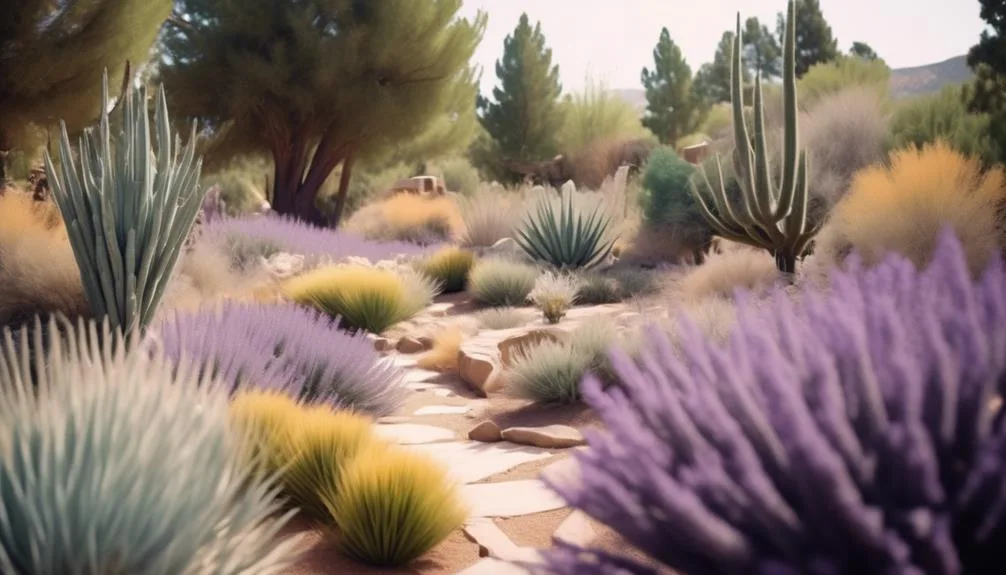Are you familiar with xeriscaping? It's not just about succulents and cacti.
Have you ever thought about adding spruce trees to your water-wise landscape? Spruce trees not only bring greenery and tranquility but also provide shade, conserve water, and enhance sustainability.
In this article, we'll explore how spruce trees can be integrated into your drought-tolerant landscape design, offering both beauty and practical benefits.
Selecting the Right Spruce Tree Varieties
When choosing spruce tree varieties for xeriscaping, consider the specific water needs and climate adaptability of each variety to ensure successful integration into your landscape. Opt for drought-resistant spruce varieties such as Colorado blue spruce or Black Hills spruce, which are well-suited for xeriscaping due to their ability to thrive in low-water conditions.
Proper soil preparation is crucial for the success of spruce trees in xeriscaping. Ensure the soil is well-draining by amending it with organic matter such as compost or peat moss. This helps the soil retain moisture without becoming waterlogged.
Additionally, a layer of mulch around the base of the trees aids in moisture retention and weed suppression.
Incorporating Spruce Trees Into Xeriscape Layout
To effectively incorporate spruce trees into your xeriscape layout, carefully consider their placement and surrounding elements to maximize their visual impact and water-saving benefits. When integrating spruce trees into your xeriscape design, keep the following in mind:
- Position the spruce trees strategically to provide shade and reduce water evaporation.
- Surround the trees with mulch to retain soil moisture and suppress weed growth.
- Choose drought-tolerant plants and ground covers to complement the spruce trees and minimize water usage.
- Utilize hardscaping elements like rocks and gravel to create visually appealing and low-maintenance areas around the trees.
- Implement efficient irrigation systems such as drip irrigation to ensure targeted water delivery and minimize waste.
Incorporating these elements won't only enhance the aesthetic appeal of your xeriscape layout but also contribute to water conservation and drought-tolerant landscaping.
Care and Maintenance of Spruce Trees in Xeriscaping
Now, let's explore the essential care and maintenance practices for ensuring the health and longevity of spruce trees within your xeriscape design. Proper pruning techniques are crucial for maintaining the shape and health of spruce trees. Regularly remove dead or damaged branches to promote air circulation and prevent disease. When pruning, make clean cuts just outside the branch collar to facilitate quicker healing. As for the watering schedule, it's important to provide deep, infrequent watering to encourage deep root growth. A 3-4-5 rule can be beneficial, which means watering trees every three weeks in spring, every four weeks in summer, and every five weeks in fall. This encourages the development of a deep root system, making the trees more resilient to drought.
| Care and Maintenance Tips | ||
|---|---|---|
| Pruning Techniques | – Remove dead or damaged branches | – Make clean cuts outside the branch collar |
| Watering Schedule | – Follow the 3-4-5 rule | – Encourage deep root growth |
Designing With Spruce Trees for Visual Impact
Design your landscape with spruce trees to create an impactful visual statement that adds texture and structure to your xeriscape design. When designing with spruce trees for visual impact, consider the following:
- Creative Pruning: Explore creative pruning techniques to shape your spruce trees into unique forms, such as topiaries or spirals.
- Seasonal Interest: Select spruce tree varieties that offer year-round interest, including different colors and textures for each season.
- Contrasting Foliage: Pair spruce trees with plants that have contrasting foliage to create visual interest and depth in your landscape.
- Layered Planting: Use spruce trees as a backdrop for layered planting, with lower-growing plants in the foreground to create a sense of depth.
- Accent Lighting: Illuminate your spruce trees with strategic accent lighting to enhance their visual impact during the evening hours.
Maximizing Environmental Benefits of Spruce Trees
Maximize the environmental benefits of spruce trees in your xeriscape design by harnessing their natural attributes to enhance sustainability and ecological impact.
When strategically placed, spruce trees can aid in water conservation by reducing evaporation from the soil and providing shade, which helps to maintain soil moisture.
Their dense root systems also contribute to soil improvement by preventing erosion and promoting water infiltration.
Furthermore, spruce trees can enhance soil quality by adding organic matter as their needles decompose, enriching the soil with nutrients.
By incorporating spruce trees into your xeriscape design, you can maximize their environmental benefits, creating a more sustainable and ecologically friendly landscape.
Utilizing spruce trees in these ways not only enhances the beauty of your xeriscape but also supports environmental conservation efforts.
Conclusion
Incorporating spruce trees into xeriscaping offers both natural beauty and environmental benefits.
Creating a visually appealing and sustainable landscape, spruce trees are a valuable addition to any xeriscape design.
With their water conservation qualities and wildlife habitat support, spruce trees enhance the ecological balance and aesthetic appeal of your outdoor space.

My interest in trees started when I first saw the giant sequoias in Yosemite.
I was a teenager then, and I remember thinking, “I need to learn more about this.”
That moment stuck with me.
A few years later, I went on to study forestry at Michigan Tech.
Since graduating, I’ve worked in a mix of hands-on tree care and community education.
I’ve spent over ten years helping people understand how to plant, maintain, and protect the trees in their neighborhoods.
I don’t see trees as just part of the landscape.
They are living things that make a real difference in our daily lives.
